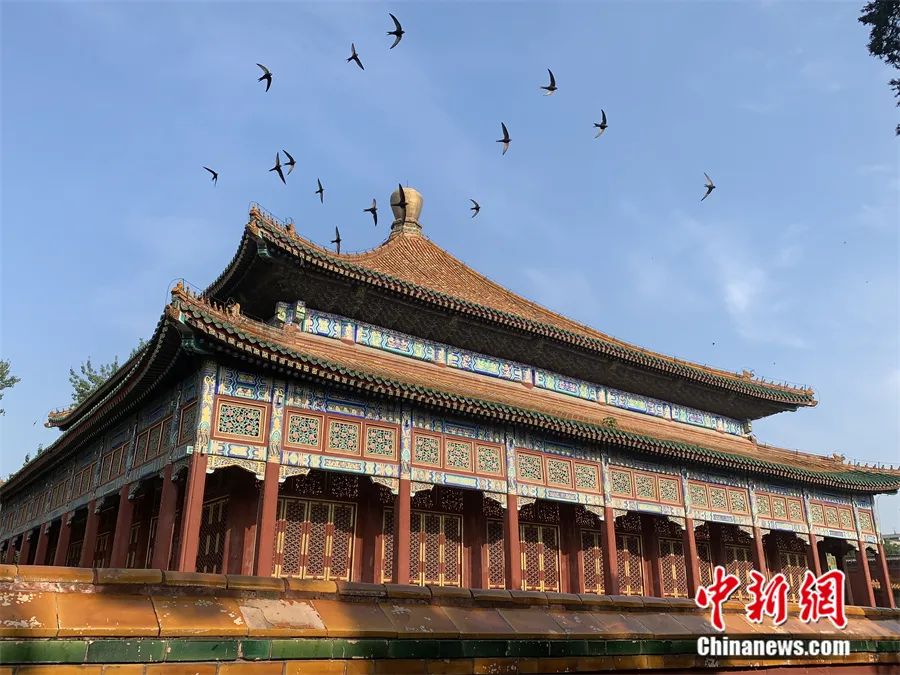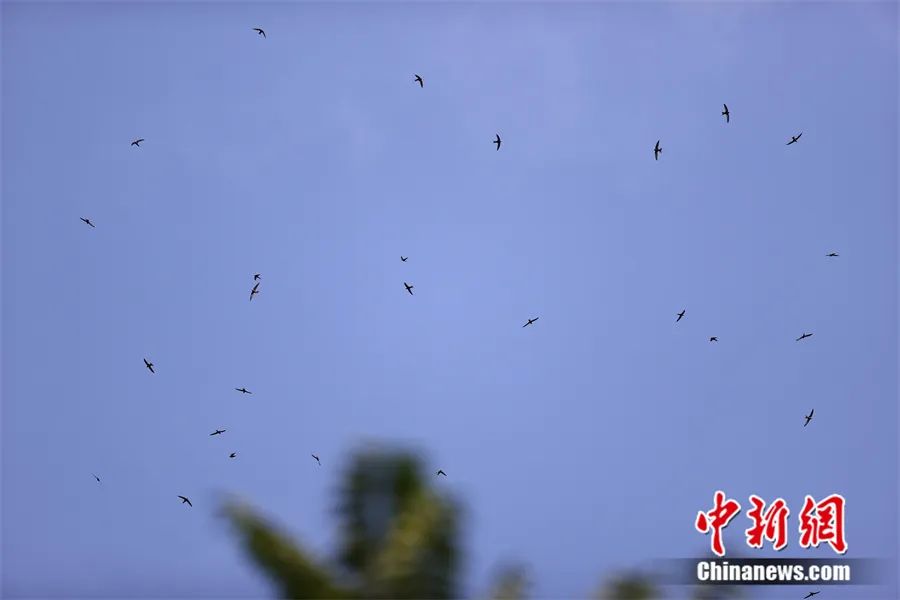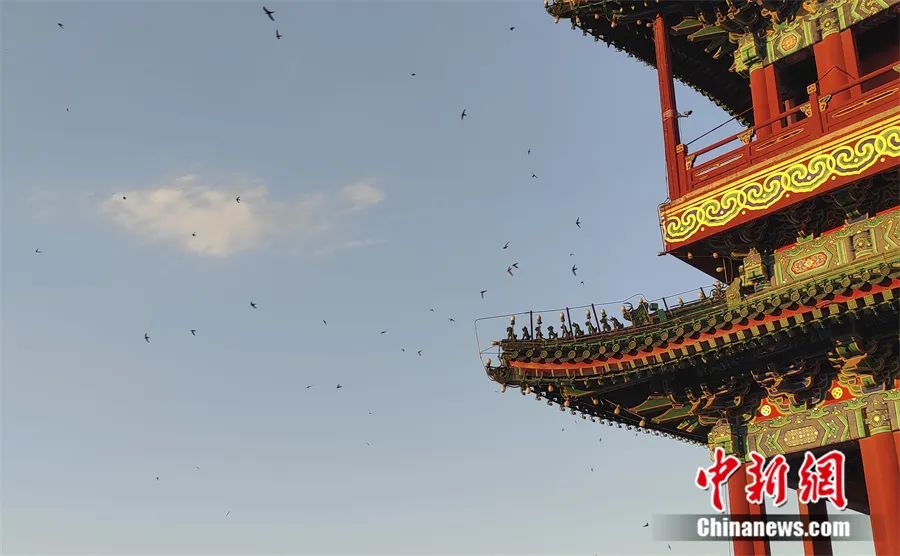Shi Yang: Flying over the "Belt and Road" every year, why is Swift the "Ecological Ambassador" because of Swift?丨 丨 东西 东西
Author:China News Weekly Time:2022.08.16

Yansan's habitat in Beijing is continuously expanding
This is inseparable from the biological diversity of the entire city in Beijing
Constant enrichment
Author: Xu Jing, Du Yan
Number of full text: 2956
Estimated reading time: 10 minutes

Beijing Swift is the only wild migratory bird named after "Beijing" in the world. In 1870, it was first collected by British birdist Robert Swenhou in Beijing for the first time and named it. Every spring, they fly from southern Africa to Beijing, setting up their nests and breeding offspring in ancient buildings in tall and magnificent and large -scale. By July to August, he departed from Beijing and flew back to Africa via the Asia -Europe continent. Most of the countries where Swift migrates through the "Belt and Road" is located along the "Belt and Road", known as the "Ecological Ambassador" on the "Belt and Road".
From the prototype of the Fuwa "Nini" in the 2008 Beijing Olympics, to the first digital image of the Beijing central axis in 2022, the "Beijing Swift" that passed through hundreds of years of storms and rain can be described as history Beijing, Culture Beijing, Ecological Beijing One of the representatives.
Shi Yang, a senior engineer of the Beijing Wildlife Rescue Center, recently accepted an exclusive interview with China News Agency's "East and West" to tell the story of "Beijing Swift" traveled to and from to explain the Beijing plan and actions of biodiversity protection.
Abstracts are currently recorded as follows:
Reporter of China News Agency: Where does the name "Swift in Beijing come from? Is there a similar kind in other cities in China, as well as cities in other countries and regions in the world?
Shiyang: Swift is widely distributed around the world. Chinese Swift is more common in the northeast, North China and Northwest China. It can be distributed south to northern Sichuan, western Hubei and northern Jiangsu.
Speaking of "Beijing Swift", Chinese is officially named for ordinary rain swallows. British birdist Robert Swinhou first collected this sub -species in Beijing in 1870, named APUS APUS Pekinensis, which named it.

Beijing Swift. China News Agency reporter, Toshida Photo
We often sing: "Little Swallow, wearing flower clothes, here in spring", the swallows here are Jiayan. In fact, Beijing Yanyan and Jiayan are not "close relatives".
Swift is the night hawk, belongs to the poultry; and the Jiayan and Jinyanyan belong to the birds. From the perspective of the body structure, Yanster is not like the three toe in the front and one toe of the family, and its crickets are short, and the four toes of the toes are forward. This makes it difficult for them to support the body after landing. Walking on the ground, it is not possible to take off with the driving force of the legs like other birds.
Therefore, Yuyan tried not to land. Only when nurturing young birds can Swift live in the cliff or fall on the giant wooden branches. Usually, during the flight, the two feet of Swift will put it in the feathers, as if a bird without a foot fly freely in the air.
Swift, known as the "Foot Bird", is generally fully expanded when flying, and the narrow wings are generally fully expanded to form a arc with a speed of more than 100 kilometers per hour. The beak of Swift is very short. Unlike other birds to "catch" bugs with a beak, but during the flying process, Zhang Daqi let the flyworm "self -invested". Even if you drink water, he passed by the beak from the water.
Studies have shown that Swift has almost never landed in his life, even mating and resting in the air.
China News Agency reporter: Why do Beijing Swift like tall ancient buildings? What is their living conditions in a modern metropolis like Beijing?
Shi Yang: Every spring, Beijing Swift flew back from Africa back to Beijing to inhabit and reproduce from Africa. Citizens and tourists are in Zhengyangmen City Tower, Summer Palace Kanti Pavilion, and Kowloon Pavilion in Beihai Park. They can often see royous swallows passing by. Old Beijingers call the swallows "Louyan".

Flying on Swift above Beijing Beihai Park. China News Agency issued a picture of Beijing Wildlife Rescue Center
It is said that Yanyan likes to like ancient buildings, and it must start with its "nature". On the one hand, there are many magnificent ancient construction eaves in Beijing, and the beams, crickets, and 椽 are crisscrossed, forming a wooden "artificial cave", which provides the ideal breeding place for Swift and can effectively prevent preventive prevention. On the other hand, choose to build nests in tall buildings to build nests. For the "birdless bird" rain swallows, the body can fly in the process of falling from high altitude.
Before the founding of the People's Republic of China, Beijing basically did not have modern high -rise buildings. The Swift mainly chose royal buildings, temple ancient towers and other nests. The small and flexible figure and exquisite ancient construction of Swift became interesting, becoming the ecological symbol of Beijing's Beijing. In particular, the swallows flying in the evening have become a iconic landscape.
In recent years, the survey found that with the city's "growth tallest", the rainwans that were originally only built in ancient buildings have gradually adapted to the development of urbanization.
Judging from the current survey data, there are more rainwans that habitat modern buildings than ancient buildings. For example, in the survey last year, the maximum number of rainfisses appeared in a single point was 1,400. This data came from Baizi Bay Bridge and Tianning Temple Bridge.

Swift near Beijing Tianning Temple Bridge. China News Agency reporter, Toshida Photo
In addition to seeing rain swallows near the tall buildings of the city, in recent years, citizens have often seen flying swallows in the high altitude of the suburbs.
These are reflected from the side that the habitat of Swift in Beijing is continuously expanding, which is inseparable from the continuous enrichment of biodiversity in Beijing.
China News Agency reporter: How is the migration route of Swift "cracking"? Where will they pass during the migration?
Shi Yang: Beijing Swift's "Mystery of Journey" has only been announced in recent years.
In 2014, Chinese and foreign birdists, Huan Zhi Nengren, etc. put a group of mini -optic positioning instruments on dozens of Beijing Swift back, and they turned the "small schoolbag" over the mountains.
According to monitoring data, people found that the long -distance flight of Beijing Swift was about 30,000 kilometers, flew across Inner Mongolia, crossed the Tianshan Mountains and the Red Sea, traveled through 37 countries, arrived in southern Africa to overwinter, and returned to Beijing the following spring. The above path shows that most of the countries where Swift migrates is located along the “Belt and Road”, and they can be called the “Ecological Ambassador” on the “Belt and Road”.

Beijing Swift Flight route monitored in 2014. China News Agency issued a picture of Beijing Wildlife Rescue Center
Monitoring also found that Swift is mainly migrated on the mainland and rarely crosses the ocean. Several places will be stopped briefly. The main stop location is the Congo Basin, the southwestern coast of the Red Sea, and the south coast of the Li Hai. They also adjust the flight time according to the food conditions during the migration. For example, the overall time to move southward in the rainy swallows is longer, and the overall time to move north in spring is shorter.
In order to find out the distribution of Swift in Beijing and protect the swallows in Beijing, in 2017, the Beijing Wildlife Rescue Center and the Beijing Wildlife Protection Association and the Beijing Xuanwu Youth Science and Technology Museum launched the Beijing Swift Scientific Survey Project. Swift distribution locations conducted investigations. Many volunteers currently participating in the survey are voluntarily signed up for recruitment of the public.
As a wildlife protection department, we hope to understand the "travel path" and foraging in the "swallowing Beijing", and we also hope to understand where the swallows that are hovering in the evening will go down at night. With the advancement of science and technology, we will be able to achieve precise observation of Swift through more advanced technology means, such as using lighter positioning device and more attractive attraction of Swift, so as to carry out analysis and research, from biodiversity protection To reduce the risk of survival of Swift, some of the protection work is targeted.
Reporter of China News Agency: In recent years, Swift has attracted much attention. Beijing Swift is one of the prototypes of the 2008 Beijing Olympic mascot, the first digital image created by the Beijing central axis application, and even "flying" into the topic of this year's college entrance examination. In your opinion, what is the demonstration significance of the protection of Swift?
Shi Yang: Birds are natural elves, the best friends of human beings, and a portrayal of social civilization.
There are many types of birds around the world. In Beijing alone, if the birds with the word "swallow" are limited to the two categories of Swallowei and Swift, there are nine types, including ordinary Louyan (ie Beijing Swift). In China, the "Yan" generally lives under the same roof. "Several morning warblers fight for the tree, who has a new swallow pecking spring mud", "helplessness, how can the flowers fall, it seems that I have known Yan's return" "persuaded the king to fight branches, and the son looks at the mother in the nest" ... Birds can peek from ancient poems.
In recent years, Swift has received more and more attention, but it is not a popular research species, and Swift is not an endangered species.
However, in ecology, ordinary species are equally important. It is speculated that the scale of swallows in Beijing has reached more than 10,000, which is significantly increased from more than ten years ago.
In recent years, Beijing has built large -scale ecological sectors, forming a variety of vegetation and ecological environment. By connecting the ecological corridor, it promotes the connection and integrity of the ecosystem. At the same time, Beijing has built a group of urban forests, and has built 79 places at all levels and various types of nature protection, with a total area of 368,000 hectares, which effectively protected more than 90%of countries and local key wild animals and plants and habitats in the city.
"Beijing Land Wildlife List (2021)" shows that on the 16,400 square kilometers of land in Beijing, 596 wild animals have been reproduced, of which more than 500 wild birds. These data prove that Beijing has become one of the most biodiversity in the world.
Today, Swift in Beijing has become the first digital image created by Beijing's central axis, which is well deserved. As the only bird named after "Beijing" in the world, Beijing Swift has built a nest on Zhengyangmen for more than 600 years. It is the "Old Beijing" on the central axis of Beijing. one.
Swift near Beijing Zhengyangmen. China News Agency issued a picture of Beijing Wildlife Rescue Center

As a wild animal researcher, we hope that Swift will not only become the messenger of the ancient capital's veins, but also drive the public to pay attention to more wild birds, pay attention to more wild animals, and further promote Beijing to build biological diversity capitals.
Introduction to the interviewee:
Photo by Du Yan, a reporter from China News Agency

Shi Yang, senior engineer of Beijing Wildlife Rescue Center, head of the Beijing Swift Investigation Project. He has been engaged in wildlife rescue for nearly 20 years, and is particularly good at bird's rescue. The main task of the Beijing Swift Survey Project is more than 20 places in the Beijing urban area with a place where the rainwans distribution is distributed to investigate their nest sites, quantities and other information. From April to August each year, as of now, according to the survey data speculation, the Swift type group in Beijing is speculated that the Swift type group in Beijing region is speculative. The scale is more than 10,000.
Text Editing: Wen Longjie
Image editor: Zhang Xinglong
- END -
Jinhua Wucheng: Drought anti -drought technology to send tea gardens to work together to protect the fragrance of tea

After the tea garden is drought, do not perform agricultural operations such as pi...
Six young scientific and technological personnel in Fengxian entered the Shanghai selection star program!Focus on biomedicine and other fields!

A few days ago, the results of Shanghai's 2022 Qiming Star Program were released. ...